Between October and December 2023, Trinidadian multidisciplinary artist Shannon Alonzo created the mural Play ah mas, Play yaself as part of her two-month CCI artist residency at Bakehouse Art Complex. Expanding her research on Caribbean Carnival and the female body as sites of liberation, Alonzo sought to explore how women have historically challenged the boundaries of corporeal autonomy and spatial engagement through ritual, assumption of personae, and collective action.
On December 7, 2023, consistent with her practice of “transforming through performance,” Alonzo intervened in the original mural, slowly and methodically erasing some of its details as a way to emphasize the ephemerality of Carnival—a time when people give themselves over to the transience of the moment and its inevitable loss. Alonzo’s actions aimed at mirroring the embodied, nonlinear nature of time that exists in each instance of a ritual performed or a character assumed during the festivities, giving rise to an ever-evolving archive of Caribbean narratives.
Alonzo’s performative action took place during Bakehouse’s annual Miami Art Week event and was organized within the framework of Beyond Representation, a research and exhibition project focusing on performance art practices from the Caribbean and its diasporas organized by Andrew W. Mellon Caribbean Cultural Institute Curatorial Associate Iberia Pérez González at Pérez Art Museum Miami (PAMM).
The following conversation explores how Caribbean Carnival practices and traditions have influenced Alonzo’s artistic production, the role the performative plays in her visual practice, and the various strategies she employed or experimented with in the creation of this piece.
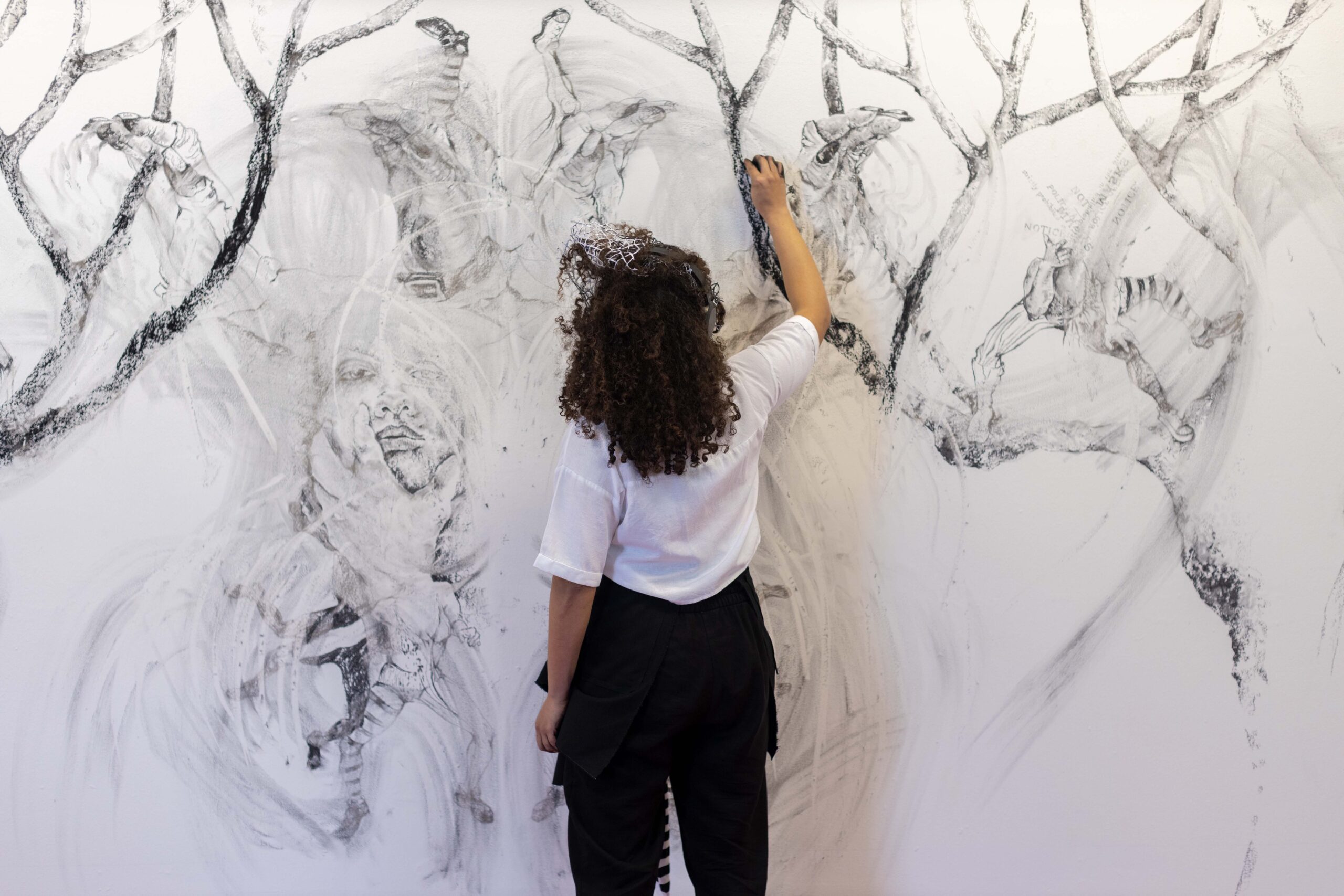
During performance, Bakehouse Art Complex, Miami.
I: Belonging
Iberia Pérez González (IPG): Much of your visual art practice has been inspired by Carnival, which is one of the Caribbean’s most deeply rooted performative traditions and cultural expressions. How do you situate your practice within the context of Carnival culture in Trinidad?
Shannon Alonzo (SA): Carnival has always fascinated me. As a child, my mother enrolled me in “Kiddies Carnival” in Trinidad, and I think this early experience was my first encounter with the transformative nature of the festival. I was a quiet, somewhat reserved child, but something about the combination of costume, music, people, and procession awakened a spirit in me like no other. Suddenly, I could shed the expectation that I had to be “proper” or “well-behaved” and embrace a body that moved freely, almost wildly, without constraint. This was my first taste of the power of collective action that exists within the Carnival realm and the phenomenon of liberation of the group giving rise to liberation of the individual.
IPG: Can you tell us how your background in fashion and previous work in costume design influenced the development of your artistic practice?
SA: As an adult, I worked for several years on costuming in and around Carnival, which deepened my engagement with its rituals in a tangible way. I realized that there is an incredible connection between the work of multiple limbs in bringing the mas to life. The movement of hands, which stitch fabric and sequins, bend wire and fiberglass rods, hold bois (sticks) in the gayelle (stickfighting ring), mirrors the gestures of masqueraders on the road. It is a language of limbs, holding a subconscious knowledge that can only be read or understood within the bounds of the festival—a language that houses our stories as a people in a fashion unlike any traditional archive. It’s dynamic and ever evolving, reflecting the state of the nation, popular culture, and the motivations of its performers and storytellers. I often return to a quote from Milla Riggio, who wrote that in Trinidad, “All make a place for themselves on the Carnival road and in the alternative temporal and cultural order that this road epitomizes.” 1 I think that this describes, so succinctly, the idea that the road, as a physical and temporal space, becomes a portal during Carnival. We engage in an annual pilgrimage where we can walk alongside our ancestors, sharing their rhythms, gestures, and joy.
Another reason that Carnival has featured so heavily in my work over the past few years has to do with my interest in notions of belonging and place attachment. Having lived outside of Trinidad for many years, I found myself questioning (through my practice) what engenders a feeling of rootedness to a space. In a broader sense, I wondered what factors could cause a population as diverse as that of Trinidad, which was constituted in its current form largely through colonialism, to recognize this space as home. In this regard, I think that Carnival has operated as a vessel for developing a sense of belonging and rootedness, particularly in the way that it encourages a renegotiation of how the body navigates and interacts with the environment.
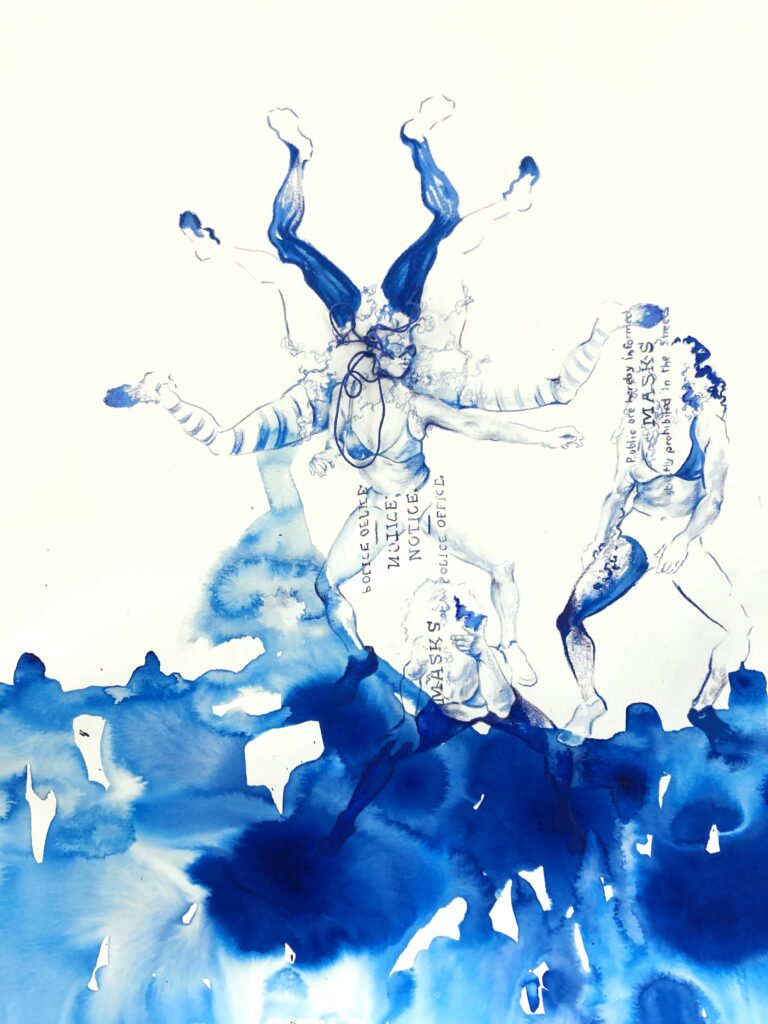
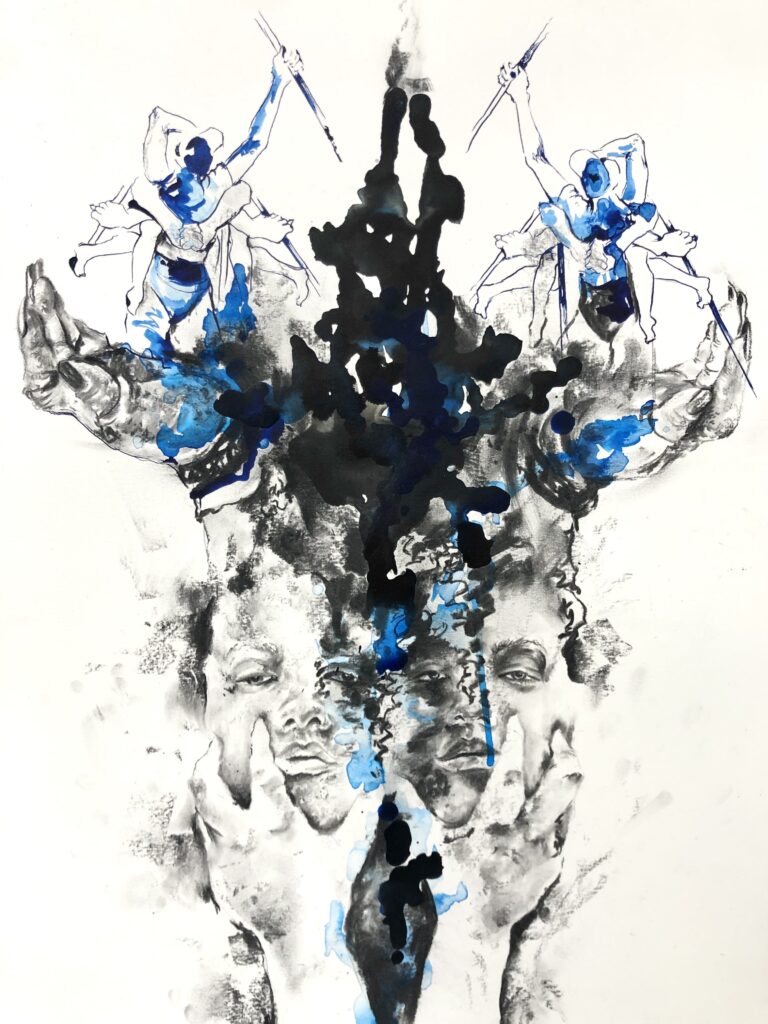
IPG: Within the context of the CCI Fellowship, you expanded your research on Caribbean Carnival by focusing on the female body as a site of liberation. Can you elaborate more on the archival research that motivated your interest in this topic?
SA: Although I have been investigating Carnival for some time, the shift in my research toward the female character and body came as a result of a prior mural project titled Mangrove, which I created for the Liverpool Biennial in 2023. During the development of this work, I came across one of Trinidad’s national heroines Elma Francois, who was a key figure in the labor movement of the 1930s and a true revolutionary in her own right. Despite her status and contributions to our society, she remains largely unknown to many (including to myself at the time), which led me to question the absence of female voices in the archive and how this can be contrasted with their significant and ever-evolving presence on the Carnival road. As I began to investigate, I realized that there has been a shift from the inception of Carnival in Trinidad, which favored male-centered performance, to the contemporary Carnival, which is dominated by women—a trend that has been mirrored in several diasporic Carnivals. To me, it seems that the Carnival realm has provided a platform in which women can feel empowered to occupy space through the embodiment of multiple personas that come together to approach a more authentic, liberated self.
I was also intrigued by the specific traditional female characters of Trinidadian Carnival, which have evolved in large part to give voice to those who are unseen and unheard—a rebellion of sorts—through masking. The “Jamette,” for example, leans into the stereotypes attributed to society’s “undesirables” to reclaim their power through sexual assertiveness and agility in stickfighting. The ways in which they wield their bodies defies what is deemed “respectable,” and their behavior and attitude has in many ways influenced the overarching spirit of contemporary female masquerade. Similarly, the “Baby Doll” masquerade highlights issues around the exploitation of the female body and the consequences and stigma of bearing so-called illegitimate children.
When considering these characters and the role they play in holding up a mirror to society, I’m reminded of Gerard Aching’s notion of “demasking” and how it brings about the “shock of self-recognition.” 2 My interest in this phenomena dovetailed with a discovery of 19th-century masking prohibition notices employed by colonial authorities to curb the masquerade of the masses. These suggest that masking is such a threat to power that it must be suppressed at all costs. Although enforcing subjects to be “unmasked” renders them physically visible, the individual is simultaneously denied the dignity of being truly “seen.” I question whether engaging in masking offers the opportunity to present multiple facets of oneself, multiple hidden personae. What is the impact of this on the way you interact with people and spaces? This led to my conceptualization of the project in part as a rebellion against the paradox of the unmasked/unseen subject.
IPG: At what point did you begin incorporating performance into your visual art practice?
SH: While completing my master’s degree, I developed a series of drawings that was intended to imagine the pages of a textbook containing untold histories. As part of the project, I experimented with “spilling” my drawings from the page onto the wall, considering the ephemeral quality of histories that remain undocumented in traditional archives. During my residency at Alice Yard in 2020, I developed this idea further by working directly on the wall with charcoal, this time focusing on how I could use the erasure and re-inscription of several drawings on a single wall to echo the cycles present within Carnival. Specifically, the remnants of histories and peoples past, which exist alongside new performances and players on the Carnival road. This notion of layering to create a sort of palimpsest was, I believe, the catalyst for developing these moments of transformation as performance.
By allowing an audience to view the transformation, I hoped to evoke a sense of loss alongside one of catharsis, sentiments that I believe coexist, sometimes subconsciously, when we engage with Carnival praxis. I also wanted to embrace the spontaneity of the road through my approach to reworking the wall, which exists in contrast to the more deliberate, measured approach to the drawing, which may take several weeks to complete. In approaching these moments of performance, I often return to bell hooks’s notion of remembrance through reenactment. Perhaps what my conscious mind cannot comprehend, my body is able to access through its movement—a connection with peoples, places, and actions removed by time.
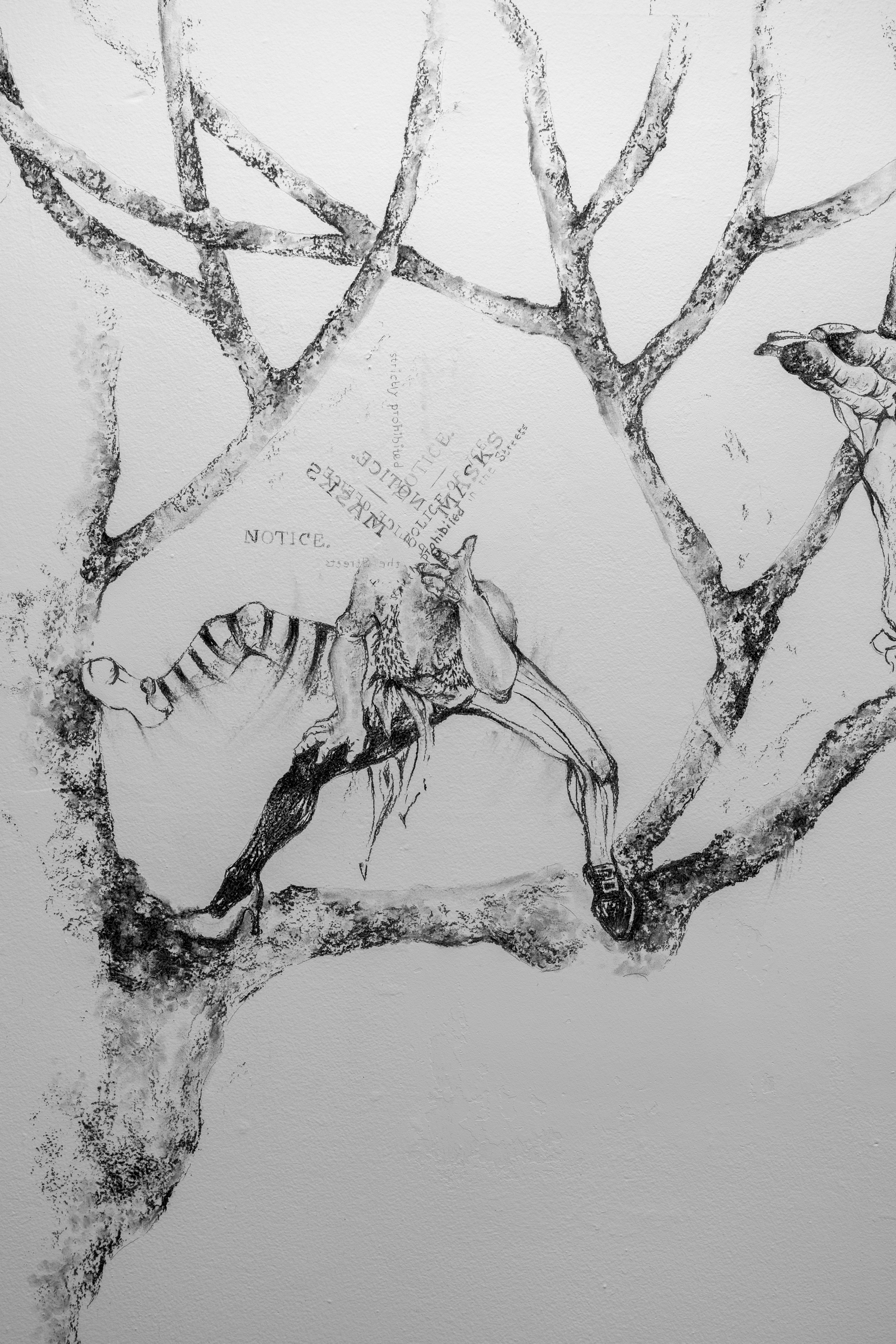
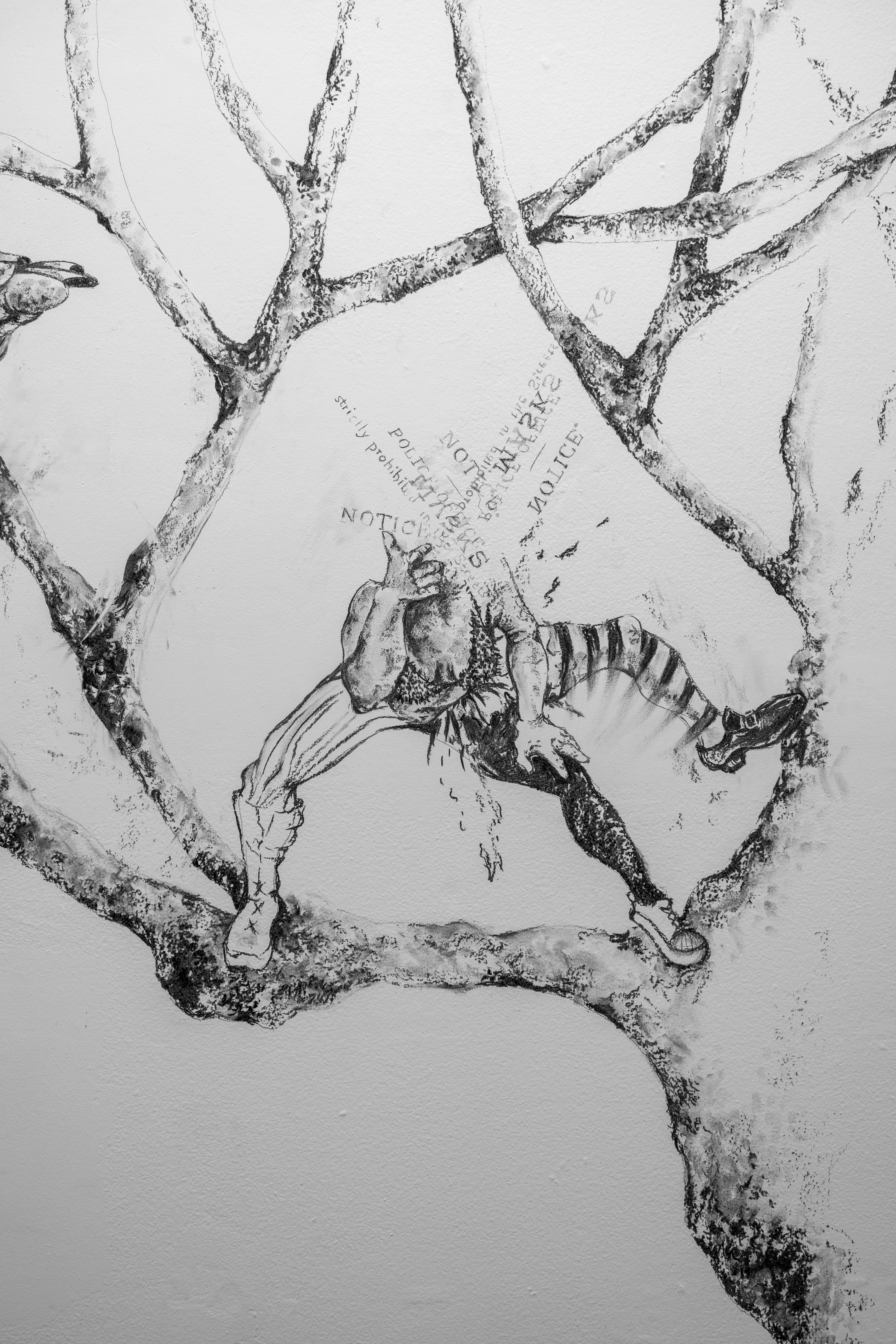
Shannon Alonzo. Detail of Play ah mas, Play yaself, 2023. Charcoal and graphite mural. Photo: Diana Espin.
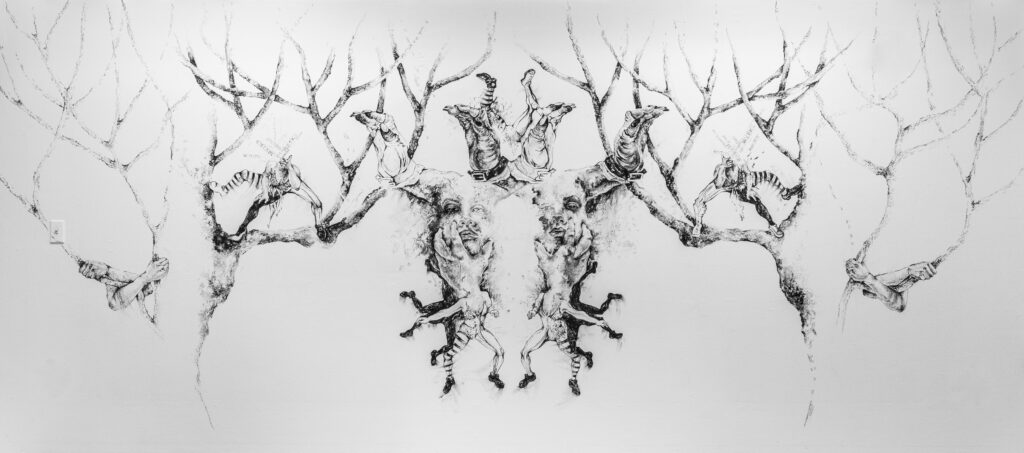
IPG: Can you tell us more about your iconography and composition and the process of making the mural?
SA: In addition to sketches and research, I wanted the core of my preparation (and the visuals themselves) to be grounded in performance. As such, I engaged in solitary studio movement, which I documented and used as the basis of many drawings. I was particularly interested in the articulation and gestures of the limbs when responding to Carnival rhythms, and even in the absence of others, I wanted to embed myself in the spirit of the movements shared by the masqueraders. I used these images to experiment further with the multiplication of limbs, which I often use to signify the role of collective action in building and rewriting (or overwriting) the Carnival story.
Unlike previous compositions, I was drawn to mirroring and symmetry in this mural, concentrating on the tension between something that appears the same but can never truly be superimposed. I’m intrigued by the (literal) dance between the conscious and subconscious selves that occurs when embodying a persona on the Carnival road. This is also linked to my use of the self-portrait and the notion of “Play ah mas, Play yaself,” which to me, signifies the function of masking as a conduit to sharing a more authentic version of yourself.
The mangrove is another motif that recurs in many of my works. Here, the roots appear upside down, reaching for a “grounding” that does not exist. I consider Carnival’s role as an agent of “rooting” to a physical space, while through its gestures, it also transports us to multiple temporal spaces.
II: Transformation
IPG: Throughout the performance, you were enacting certain elements that are usually present in Carnival. For instance, the processional as you walked from the studio to the platform where the performance took place. This was the first time you incorporated this element into your practice. Can you speak to that a bit?
SA: The idea of procession is critical to Carnival as masqueraders are so rarely static, and I think it is this movement that informs or builds the connection to our environment and the way we negotiate within it. The decision to incorporate this into my performance was in part to evoke this sense of journeying through a space, as well as to catalyze within myself a sort of Carnival persona or alter ego that would fuel the remainder of the performance.
IPG: Another new element you incorporated into the work is a headpiece. Can you speak a bit about the significance of the headpiece to the performance and its relationship to Carnival concepts of masking/masquerading, persona, etc.?
SA: For me, the mask holds several practical and conceptual functions. From the early development of my proposal for the fellowship, I considered adding it as an element, particularly because of the archival masking prohibitions I was engaging with to build the concept and composition of the mural. I’m interested in the tension that exists between the “seen” and the “unseen,” particularly when the mask or masking acts as a conduit for a greater or more authentic revelation of self. I believe the notion of masking carries with it a unique opportunity to empower performers to reveal facets of themselves that may otherwise lay dormant. In the case of the female figure in Carnival, I think the self-consciousness that is bred into our collective psyche can, in some instances, be superseded by this power. Defiance can then take center stage without fear of repercussion, opening up a world of possibilities for the liberated body.
The mask also creates a literal barrier between performer and audience, which is where the practical considerations come into play for me. In several instances where I have undertaken this type of performance, the audience has been able to witness me from multiple angles and was quite close to me as I was working, so then the mask became a way for me to avoid breaking my rhythm through eye contact with viewers.
The material that I used to create the mask was netlike and therefore only partially obscured my view and that of the audience. I wanted it to have an organic feel, reminiscent of the mangroves featured in many of my works, interwoven with locks of my hair as if it may have grown from me as opposed to having been fashioned by me. This connection to land is always a prominent concern in my work, and I want my own Carnival persona to feel as if it is an extension of the natural world, with the edges between body and nature intentionally blurred.
IPG: During your performances, you wear headphones and play soca music as a way of getting into character, evoke your carnival persona, and re-create the energy of playing mas. Can you expand a bit on this aspect?
SA: My music is, in some ways, the most critical element of the performance. Historically it has been a vital ingredient of not only performance in Trinidad, but also our rebellion against cultural suppression. It is a way for me to transcend the everyday and to draw upon an energy, a consciousness, that usually only lives on the Carnival road. In the past, I have referred to this phenomenon as an embodied ascendancy; through rhythm, movement, and procession, we come to a greater understanding of ourselves, one another, and the environment we inhabit. I’m fascinated, however, by the passage of this energy and how it is transmuted during the time between Carnival seasons. By evoking it during my performances, I try to understand and pay homage to the “quiet spaces” between festivals, when this energy lies dormant.
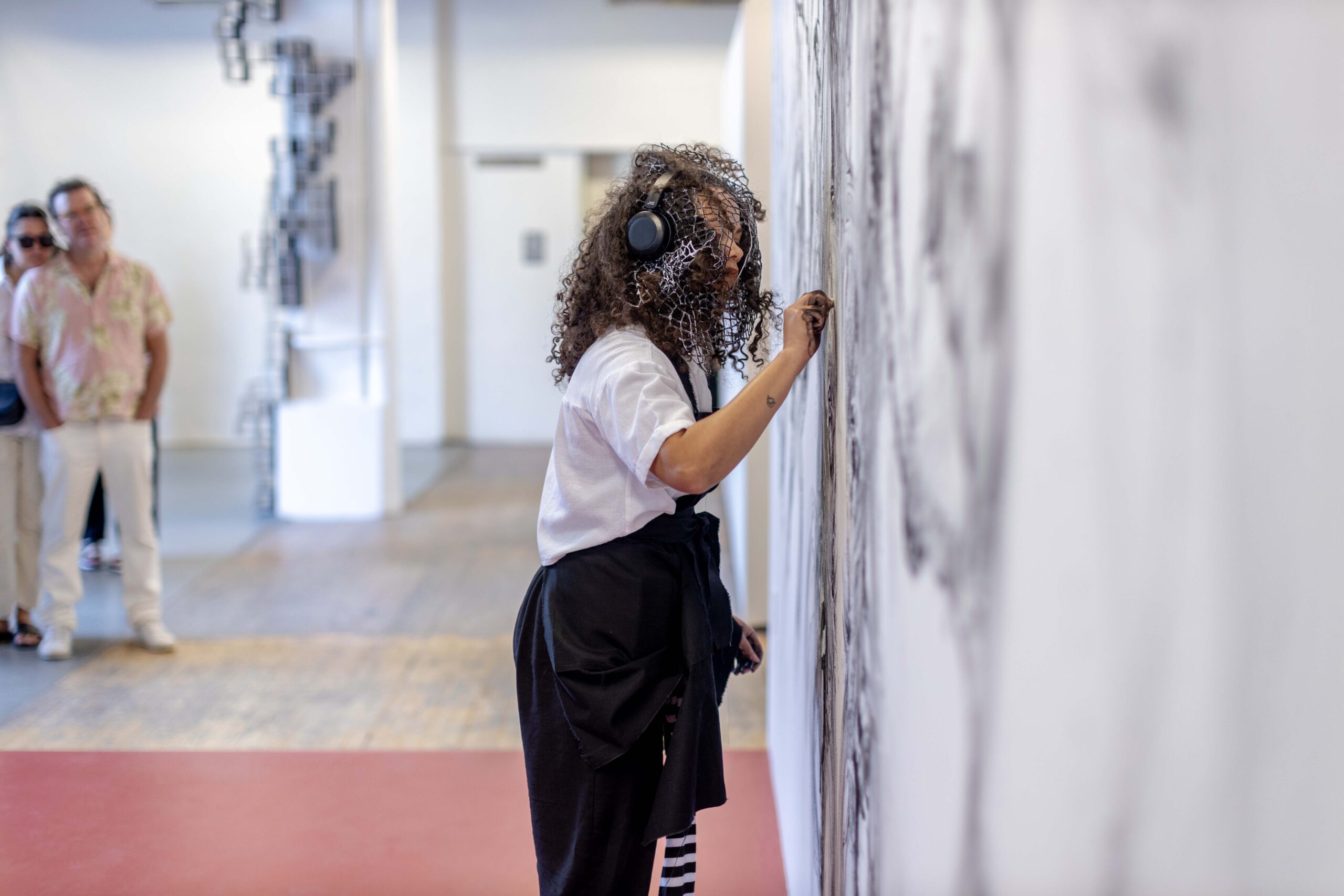
During Performance, Bakehouse Art Complex, Miami.
IPG: This idea of the “silent Carnival” feels like an oxymoron, but that aspect of the performance is quite fascinating precisely because of the disconnect it creates with regards to the audience. If performance art and Carnival usually rely on audience interaction and participation, it is interesting how the lack of access to that soundscape denies the viewer the possibility of taking part in an essential aspect of Carnival, one that comes with experiencing the rhythm and vibration of the music through the sound systems. Can you share your thoughts on this and how you understand the role of the spectator/audience in your (performance) work?
SA: In many ways, along with the mask, my headphones extend the barrier I create between myself, the work, and the audience. I suppose it is a sort of negotiation between opening up my process and simultaneously keeping something for myself. As my performances have taken place in these “quiet spaces,” outside the sensory onslaught of Carnival Monday and Tuesday, it seems fitting that I keep this component (the rhythm) for myself. This way, it draws the audience’s attention to the visual narratives of the mural and their transformation in the moment—to narratives that can sometimes be obscured by the beautiful chaos of the road. In reflecting upon this, I have recently begun to conceptualize my engagement with the music as a Carnival of the mind. Perhaps we, as Caribbean peoples, hold this energy, this attitude and inclination to spontaneous expression inside us within those quiet spaces.
IPG: It was fascinating to see the visual resonances between your transformed mural piece and the monumental “erasure” drawings Gary Simmons created on-site as part of his Public Enemy exhibition at PAMM. Of particular interest was seeing the contrast between the gestural marks Simmons incorporates in his working process and their relation to the transience of memory and the way you employ the “erasure technique” in your previous works. Although there are some parallels in the way you use erasure with regards to the transience of time, the play between visibility and invisibility, and the tension that results from the process of mark-making and unmark-making in Play ah mas, Play yaself, you place greater emphasis on transformation, as you previously mentioned. Could you speak about this shift in your practice and how it relates to the ephemeral cycles of Carnival?
SA: All the movements and actions in my performances are spontaneous. I give myself over to instinct and the energy of the moment to mirror the spontaneity that is present during Carnival. When I first began to work in this way, I was moved to etch out far more white space, leaving the remnants as subtle hints below the surface. As time has gone on, I’ve felt inclined to work more with the original elements of the composition, blurring, smudging, and redrawing within the time frame of the performance itself. I think that this has been a natural progression, but it also speaks to the repetition that exists within the procession, where multiple performers reenact the same gestures or rituals year after year. The composition then becomes dense with layering, and it is difficult to distinguish one layer from the next.
Additionally, because I had leaned into mirroring and symmetry in my composition, they informed the movements that I made during my performance at the Bakehouse, when I attempted to treat both sides in a similar fashion and yet keep them distinct.
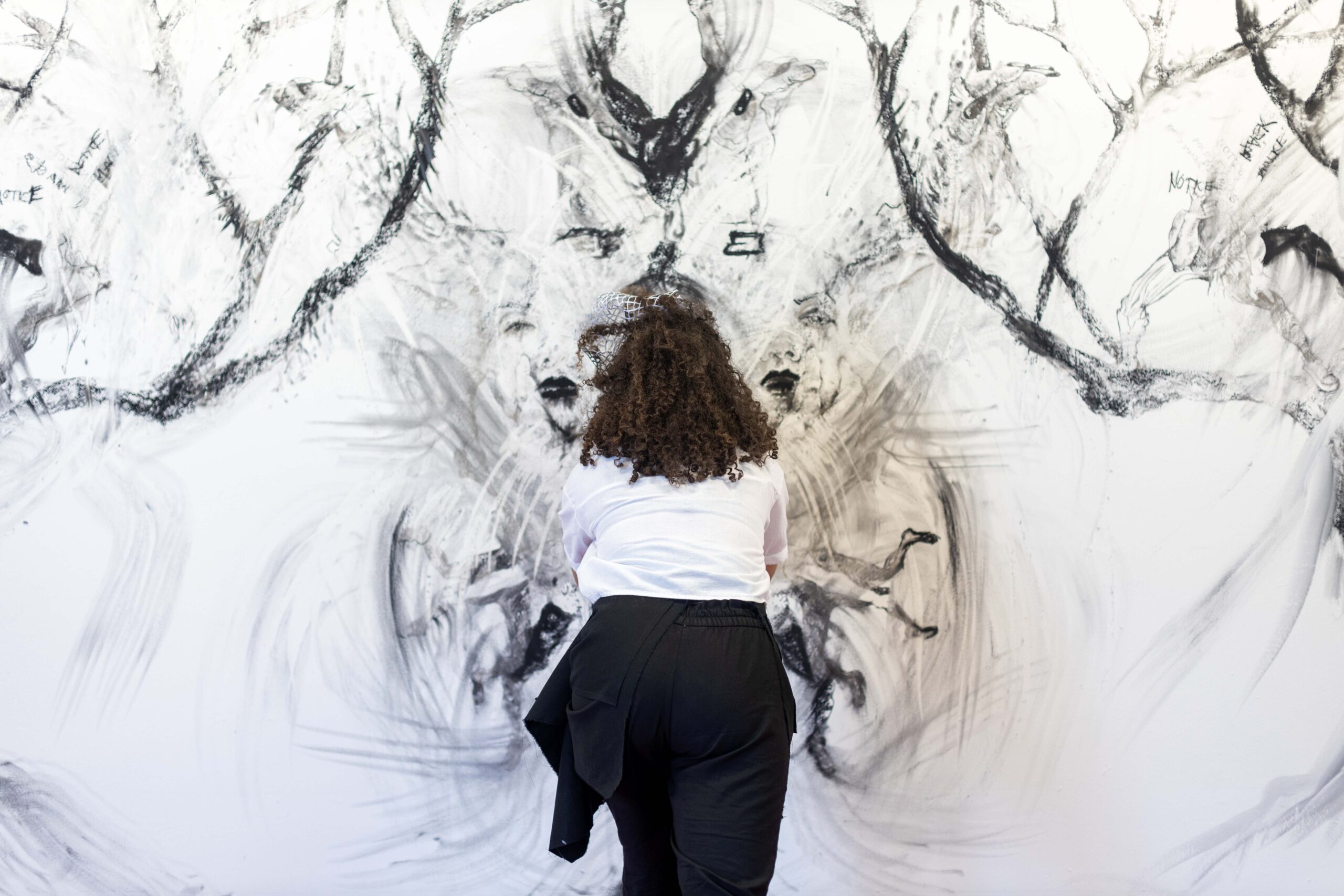
During Performance, Bakehouse Art Complex, Miami.
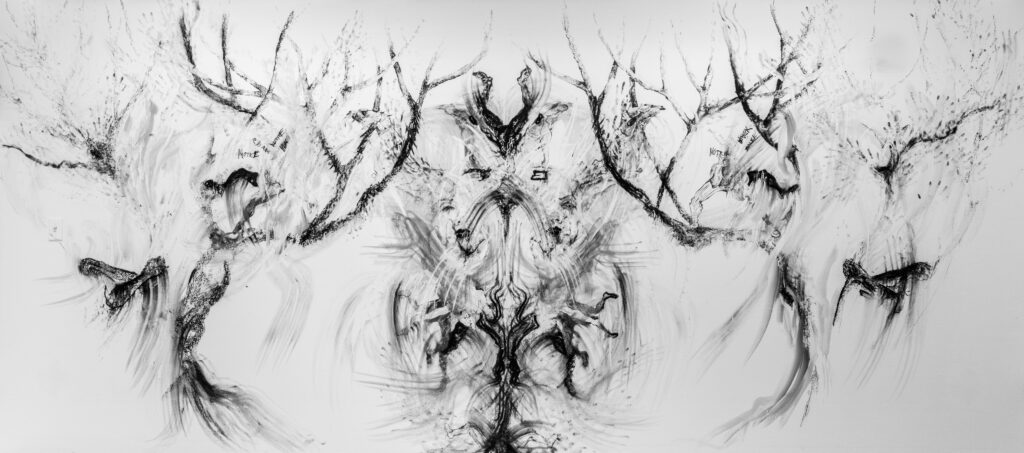
After performance, Bakehouse Art Complex, Miami.
III: Traces
IPG: Just a couple of days after your performance at Bakehouse, the Afro-Puerto Rican artist, dancer, and performance artist Awilda Sterling-Duprey presented a reenactment of her Vegigante decrépito (1999–present) at PAMM as part of Beyond Representation. Her performance was also inspired by Carnival traditions, in particular, the Puerto Rican Carnival celebrations of Santiago Apostol in Loíza. It is interesting how both of you—two artists from different generations and Caribbean contexts—approach Carnival and performance in such distinct ways. However, there seemed to be similarities in the ways that you use masking and connect music and performance in your respective practices.
SA: Carnival has this sort of infectious, all-encompassing spirit, which is why I believe it has spread and multiplied to create such a sprawling performance geography. Witnessing Awilda’s incredible performance solidified this notion for me, as there were certain gestures or ways of masking that I recognized from my own experiences of Carnival at home. I think this almost conscious/subconscious conversation that is taking place across the Caribbean, its diaspora, and beyond is really beautiful. It nourishes a metaphysical connection that perhaps does not and cannot exist in any other form. I have read that enslaved Africans who were forced to exist in the so-called new world used dance to spiritually return to their homelands. I’m intrigued by this notion and question whether contemporary Carnivals still function to transport the spirit and perhaps create a dialogue with countless peoples across multiple spaces.
IPG: Some of your gestures and movements, in particular the way you used your hands to transform certain parts of the mural drawing during the performance, brought to mind the bloody handprints and marks left by Ana Mendieta on the white gallery wall in works like Untitled (Body Tracks, 1974) and Body Tracks (1982). In a similar fashion, after finishing the performance and exiting the performance space, you left behind your body prints for the audience to bear witness to—not only as a completely transformed image, but also as traces of human presence and action. For the two months that the mural remained at the Bakehouse, the tracks left by your fingers and your footprints acted as residual signs of your presence in that space. From our conversations, the bodily mark-making in Play ah mas, Play yaself were more intentional than in previous works, so I am interested in your perspective on how this bodily imprint in the image re-signified the original drawing conceptually and your understanding of “the female body as a site of liberation.” How did the performative aspect and end result probe or change, if at all, your initial ideas about contemporary female masquerade.
SA: In this performance, I tried to create a greater connection physically between myself and the drawing, to activate the image in some way. The “art” in Carnival is only activated through the presence and, specifically, the movement of the body. I wanted to lean into this through reworking and redrawing the charcoal. Often, once Carnival is over, the only trace of it is a rogue hand- or footprint left in paint from J’ouvert celebrations. I wondered what our cities would look like if every single footstep, every single hand, left a visible mark. Would this change our thoughts around the collaborative act of the art we made together? Which we make together, each year?
I think what is interesting about the parallels between my work and Mendieta’s is that while her movements unflinchingly bring to mind female suffering (and the silencing of that suffering), my work, conversely, is intended to mimic the remnants of movements that liberate the female body. As I mentioned earlier, many of the female Carnival characters have existed to assert agency where it may have been absent in other facets of life. In this way, I see the traces left as an ode to multiple bodies that found their safe space and most authentic self-expression in the Carnival realm.
I think that prior to the performance, the mural was a meditation on Carnival and women’s place within it, while post-performance, it became a remnant of Carnival. Without that transformation, that ritual, so to speak, the work remains distanced from its subject matter.
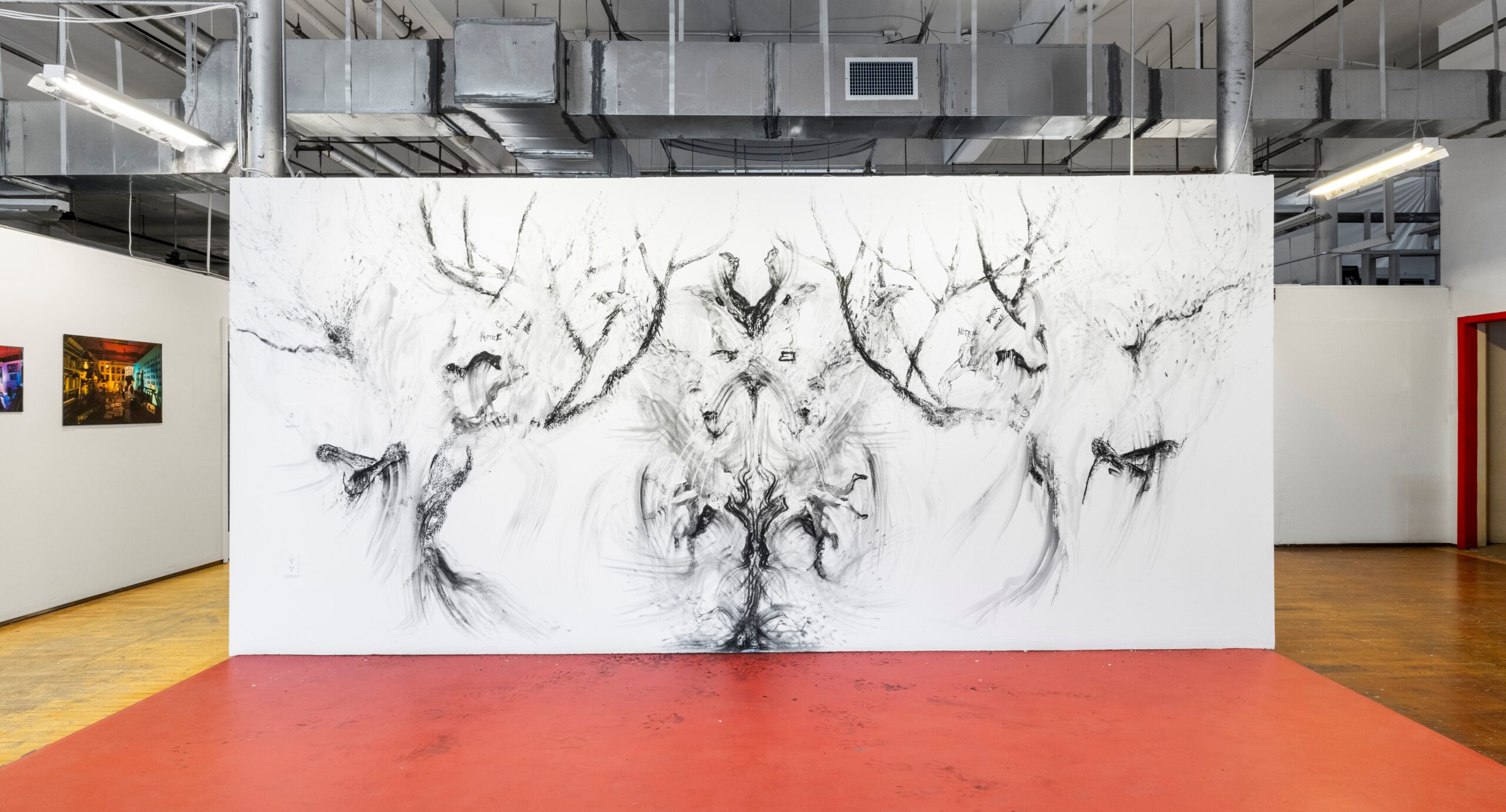
After performance, Bakehouse Art Complex, Miami.
IPG: We began the conversation by addressing the importance of context and place in relation to your practice. Can you elaborate a bit on the implications of creating and presenting a work that is so deeply embedded in the Carnival traditions of the Trinidadian context in cities like Miami or Liverpool, where although there are large Caribbean communities, the public may be more removed from this subject matter?
SA: I often ask myself this question and, truthfully, I am still unpacking the implications. What I would say is that audiences in these spaces often have had an experience of diaspora Carnivals and, in some instances, have reasonably engaged with them on a surface level. While I understand categorizing Carnival as “fun” or “a party” in these circumstances, I also think it is important to encounter a glimpse of the energy or intention behind what is taking place. What you are witnessing or experiencing, however far removed from its original conception, is a form of dynamic archive—one that has responded to oppression through joy. Bringing this to the fore can perhaps shed new light on the function of festivals such as these, while reinforcing the power of the performance geography in which it operates.
IPG: You are one of many artists from the Caribbean who will be participating in the next iteration of Prospect New Orleans, which opens in November 2024. Can you share a bit of what you are planning to present and how it relates to the work you created during your fellowship at PAMM?
SA: The conversations I engaged in during and post-fellowship caused me to consider in a deeper way how the performance of a collective and the agency of the individual can and do coexist within the Carnival space. So often in society, allegiance to a group means in some way suppressing one’s own desires or motivations. I think that there is an interesting dialogue or negotiation on the Carnival road that allows for both planned and spontaneous collaboration, as well as dignity through individual expression. I’m thinking about what it means to be fully participant and fully apart at the same time. The notion that the “whole is greater than the sum of its parts” is perhaps dispelled through these festivals, as the collective and the individual exist as equals. These are ideas that I’m exploring within the work I’m creating for Prospect.

Shannon Alonzo is an interdisciplinary artist focused primarily on drawing, soft sculpture, and performance. In her practice, she explores themes of collective belonging, place attachment, and the significance of carnival ritual in the Caribbean consciousness. Alonzo holds a BA from London College of Fashion and an MRes Creative Practice from the University of Westminster. She has exhibited her work at the Liverpool Biennial 2023, Ambika P3, and London Gallery West in the United Kingdom; Documenta 15 in Germany; Alice Yard, the LOFTT Gallery, and the Black Box in Trinidad & Tobago; and the Atlantic World Art Fair on Artsy.
- Milla C. Riggio, “Introduction: Resistance and Identity: Carnival in Trinidad and Tobago,” TDR/The Drama Review 42, no. 3 (Autumn 1998): p. 7
- Gerard Aching, Masking and Power: Carnival and Popular Culture in the Caribbean, Cultural Studies of America, vol. 8 (Minneapolis: University of Minnesota Press, 2002), p. 30
